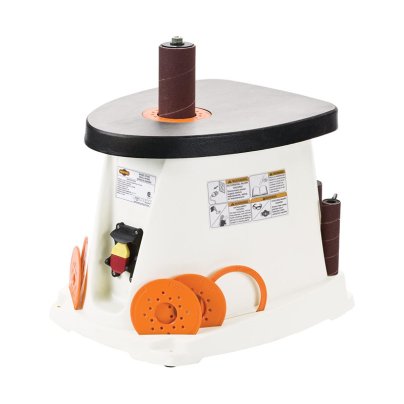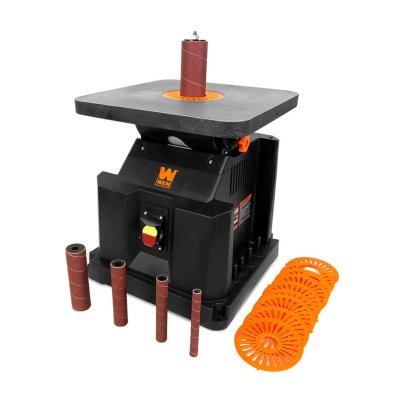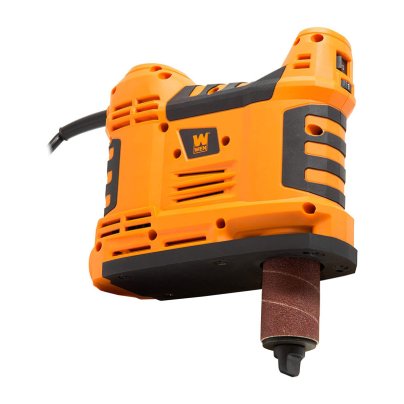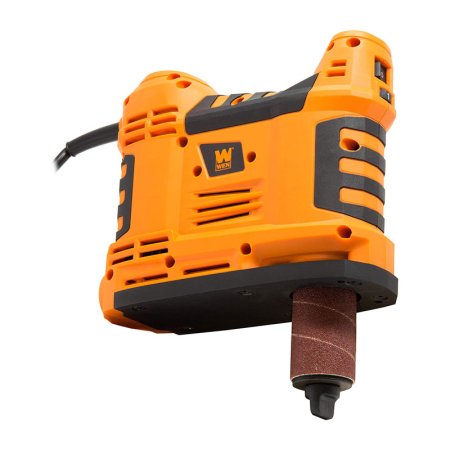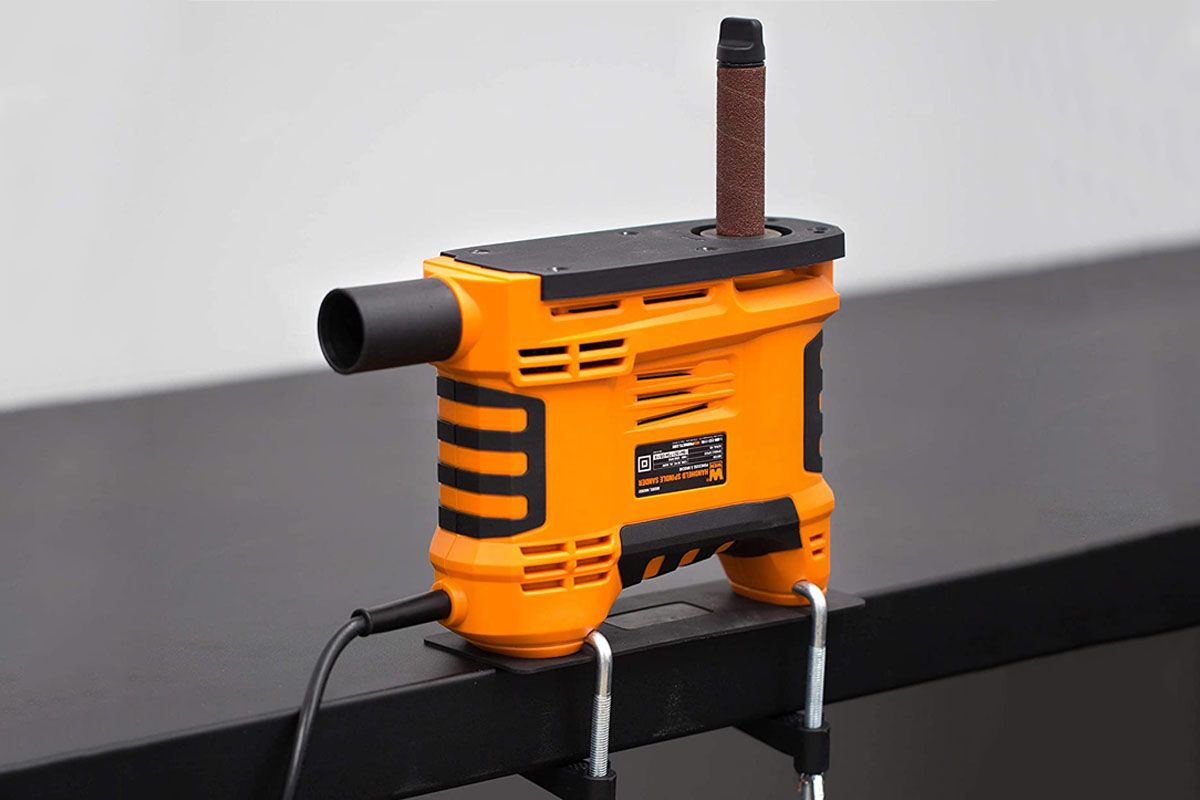
We may earn revenue from the products available on this page and participate in affiliate programs. Learn More ›
Where you’re a pro or a hobbyist, taking a woodworking project from good to great requires a bit of an edge—quite literally. Use one of the best spindle sanders to achieve smooth, even edges on woodworking projects.
Unlike bench sanders, these handy tools use spinning cylindrical sanding drums (called spindles) and flat work surfaces to sand curved boards and joints to a consistent finish. Not only do they spin the drum to sand quickly and efficiently, but the best spindle sanders also oscillate up and down to alternate the sanding direction, removing the chances for grooves or scratches in the workpiece.
- BEST OVERALL: Shop Fox 1/2 HP Single Phase Oscillating Spindle
- RUNNER-UP: WEN 3.5-Amp Oscillating Spindle Sander
- BEST BANG FOR THE BUCK: WEN 5-Amp Portable Oscillating Spindle Sander
- UPGRADE PICK: JET JBOS-5 Benchtop Oscillating Spindle Sander
- BEST FLOOR-STANDING: Delta 1 HP Oscillating Spindle Floor Sander
- BEST PORTABLE: EJWOX Portable Handheld Oscillating Spindle Sander
- ALSO CONSIDER: Grizzly Industrial 1/3 HP Oscillating Spindle Sander
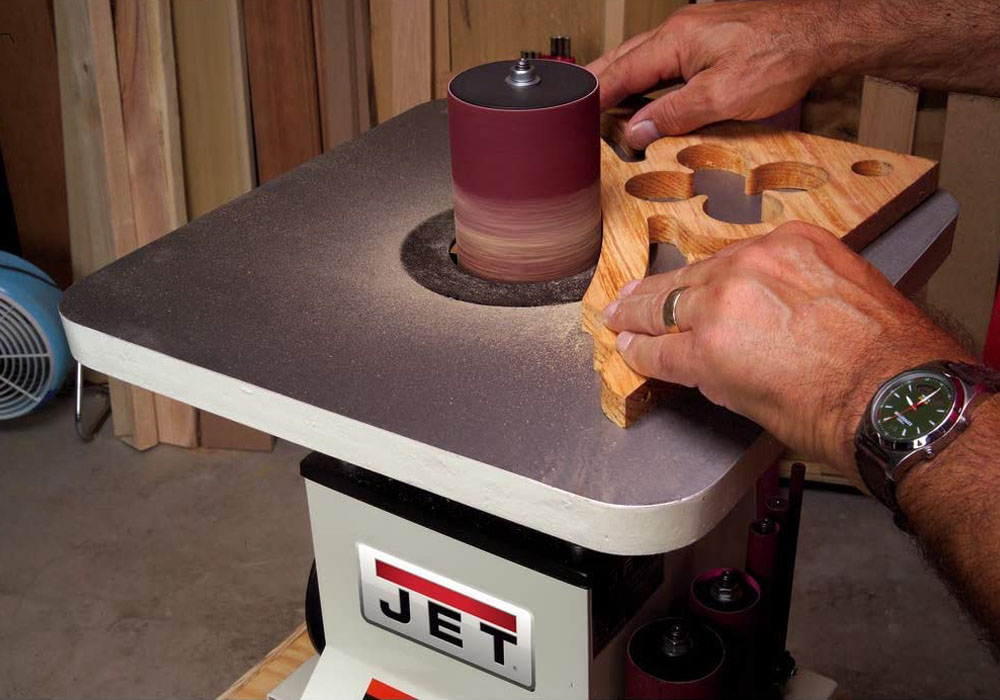
What to Consider When Choosing the Best Spindle Sander
Consider a few points when shopping for a spindle sander. From the type of spindle sander to its size and speed, learning how these tools work and what they can do helps shoppers find the best spindle sander for their needs and workshop setup.
Type
The three main styles of spindle sanders are benchtop, floor standing, and portable. All three types work similarly, but differ in size and setup.
- Floor-standing spindle sanders are taller units that stand on their own base or legs. The work tops are usually at a relatively comfortable height, making them easy to use. But they’re heavy, sometimes weighing as much as a few hundred pounds, and they take up quite a bit of floor space.
- Benchtop spindle sanders are designed to sit on top of a workbench or table, allowing the user to set them up anywhere with a flat surface. These models are much lighter than floor-standing models, often weighing just 30 or 40 pounds. This weight allows users to place them on a bench for use and tuck them away afterward.
- Portable spindle sanders are handheld tools. While not always useful for smaller pieces, they can be very helpful for sanding curves on large furniture or projects.
Size and Weight
Also consider the spindle sander’s size and weight, particularly if you have a smaller workshop or need more portability.
- Floor-standing units are the heaviest, sometimes weighing more than 300 pounds, but models with locking casters help make transporting them easier. They’re also quite large, standing approximately 3 feet high and extending at least a foot or two in either direction.
- Portable sanders are the lightest option, but working with smaller items can be tricky.
- Benchtop units typically weigh 30 or 40 pounds, so they’re light enough to lift onto a workbench but just heavy enough not to shift while in use. However, they must be set up before each use, and they’re not as effective for sanding curves on larger pieces.
Material
The spindle sander’s material matters. From the base to the work top, some materials are more desirable than others. Floor-standing and benchtop spindle sanders are relatively safe tools, but they’re easier to use if they stay in place on their own. Bases made from metal and dense plastics add a bit of extra weight to the tool. For portable models, the lighter the better, so plastic housings are usually preferred.
Work tops must be perfectly smooth and flat, and the longer they can avoid corrosion, the better. Aluminum and cast iron are excellent choices. A bit of wax across both of these surfaces can keep them smooth and corrosion-free for years to come.
Motor Power
Spindle sanders come in a variety of power ratings, which can make choosing the right model confusing. It’s helpful to think of these power ratings as:
Light duty: These spindle sanders contain motors with horsepower ratings of ⅓ and under. They’re ideal for light work such as craftwork, picture frames, and other small projects.
Medium duty: For most projects, medium-duty sanders, with ⅓ to 1 horsepower, get the job done. They can handle sanding dense hardwoods and larger surfaces.
Heavy duty: At 1 or more horsepower, a heavy-duty spindle sander is the way to go for larger projects. Moreover, they can sand almost any wood imaginable.
Speed
A good spindle sander can cover a large range. Some top-notch models might top out at 1,500 RPMs, while others sanders can reach speeds over 3,000 RPMs.
The best spindle sanders feature adjustable speeds, which can make achieving the perfect edge easier. Slowing down the speed for hardwoods helps reduce the risk of burn marks and wearing out the sandpaper too quickly, while higher speeds can remove a lot of material from a softer wood quickly.
Additional Features
Extra safety and convenience features help set the best spindle sanders apart from the competition. Look for a spindle sander with an oversize on-off switch that’s easy to find and hit if an emergency arises. For increased safety, many of these switches also feature a removable key.
Kits that come with several drum sizes not only offer extra convenience and versatility but also make creating the perfect edge a bit easier. Smaller drums are excellent for tight inside curves, while larger drums make achieving gentler curves a bit easier.
Spindle sanders can create a lot of sawdust, so consider models that include a dust collection port to help keep your work space clean.
Noise Level
When a spindle sander is running, the motor emits a noticeable hum. Finer sandpapers, such as 150 grit, don’t add a lot of noise, but an aggressive sandpaper like 80 grit can increase the noise quite a bit.
In active use, these tools can become very loud; in fact, they can be as loud (or louder) than a table saw, depending on wood species. A lot of variables can affect a spindle sander’s volume, and wearing ear protection is always recommended.
Our Top Picks
With a bit of background, choosing the best spindle sander for your shop doesn’t have to be complicated. Keeping the above shopping considerations in mind, the following list of some of the best spindle sanders should make the process a bit easier.
Best Overall
Shop Fox 1/2 HP Single Phase Oscillating Spindle
Shop Fox’s Oscillating Spindle Sander is a good choice for woodworkers with smaller workshops or who are short on bench space. This compact ½-horsepower model’s cast-iron work top weighs 34 pounds, so storing it is easy. The motor runs at 2,000 RPMs, and the drum oscillates up and down 58 strokes per minute.
The Shop Fox comes with six spindles: ¾, 1, 1½, 2, and 3 inches in diameter, and the corresponding sandpaper. It also features a 1½-inch dust collection port and an oversize on-off switch with a removable key.
Runner-Up
WEN 3.5-Amp Oscillating Spindle Sander
Woodworkers who want a bit of flexibility in their benchtop sander may want to consider WEN’s Oscillating Spindle Sander. This ½-horsepower sander has a cast-iron work surface that weighs 33 pounds. The work top bevels up to 45 degrees to create clean, smooth bevels at any angle.
This sander spins at 2,000 RPMs and oscillates 58 strokes per minute. It comes with five separate spindles, including ½, ¾, 1, 1½, and 2 inches. For easy cleanup, the WEN also features a 1½-inch dust port to connect to a shop vac to reduce the mess.
Best Bang for the Buck
WEN 5-Amp Portable Oscillating Spindle Sander
Mixing affordability and functionality, WEN’s 5-Amp Portable Oscillating Spindle Sander is a compact portable sander that’s roughly the same size as a power drill, making it easy to bring directly to a piece. It features brackets for attaching it to a tabletop, increasing its capability as a benchtop spindle sander substitute.
This spindle sander features adjustable speeds between 1,800 and 3,200 RPMs and oscillation rates between 50 and 90 strokes per minute. It comes with three rubber spindle sizes at ¾, 1, and 1½ inches. The 1½-inch dust collection port helps collect some of the mess and minimizes cleanup as well.
Upgrade Pick
JET JBOS-5 Benchtop Oscillating Spindle Sander
Woodworkers in search of a highly functional benchtop spindle sander may want to check out JET’s Benchtop Oscillating Spindle Sander. This ½-horsepower motor can handle all but the heaviest-duty work. It produces speeds of 1,725 RPMs and oscillates 30 times per minute, with a full inch per stroke.
For all its power, this benchtop model is fairly compact; however, its heavy-duty cast-iron construction means it weighs 77 pounds. Some of that weight is because of the 45-degree beveling table. Five spindle sizes, including ¼, ½, ⅝, 1½, and 2 inches, offer additional versatility. It also features a 2-inch dust port for easy cleanup and a removable on-off switch to prevent accidental start-up.
Best Floor-Standing
Delta 1 HP Oscillating Spindle Floor Sander
Delta’s Oscillating Spindle Floor Sander, a floor-standing model, features a powerful 1-horsepower motor to remove lots of material from dense hardwoods. It has a speed of 1,725 RPMs and oscillates at 71 strokes per minute, 1½ inches at a time. As expected, it has a large footprint, measuring 24⅝ inches by 24½ inches wide, and is just under 30 inches tall. Due to its cast-iron construction, it’s heavy, weighing in at a hefty 374 pounds.
This spindle sander features a cast-iron work surface that bevels up to 45 degrees. It also comes with 10 different spindle sizes between ¼ inch and 4 inches, which all can be stored on the machine. The fully enclosed base reduces noise and vibration while improving dust collection.
Best Portable
EJWOX Portable Handheld Oscillating Spindle Sander
EJWOX’s Portable Handheld Oscillating Spindle Sander is a compact spindle sander that features an adjustable speed between 1,800 and 3,200 RPMs. It oscillates between 50 and 90 strokes per minute, increasing sandpaper longevity.
The EJWOX can double as a benchtop spindle sander. By attaching the included brackets to the edge of a worktable, users can mount the EWJOX and use it as a light-duty benchtop model. It also comes with four spindle sizes and a dust collection port and dust bag.
Also Consider
Grizzly Industrial 1/3 HP Oscillating Spindle Sander
For light- and medium-duty woodworking projects, Grizzly Industrial’s Oscillating Spindle Sander is worth a look. This ⅓-horsepower model features a constant speed of 1,725 RPMs, a useful speed for a variety of projects. The drum also oscillates up and down 72 strokes per minute, reducing the risk of grooves or scratch marks in a piece.
This model weighs 35 pounds, which helps make using and storing it manageable. It has an engineered-wood work top, and it comes with six spindle sizes as well as 80- and 150-grit sandpaper. A 2½-inch dust collection port connects to an existing collection system, and the oversize on-off switch with a removable key enforces safety.
FAQs About Spindle Sanders
Even with all this background and a crash course on some of the top products on the market, you may have some additional questions about spindle sanders. The following is a collection of some of the most frequently asked questions about spindle sanders, so check below for an answer to your question.
Q. What does an oscillating spindle sander do?
An oscillating spindle sander sands curves and edges by not only spinning a drum, but also by moving the drum up and down while it spins. This helps improve the longevity of sandpaper and decreases the risk of damaging the piece.
Q. How loud is a spindle sander?
Some models are very loud. It’s always a good idea to wear ear protection, eye protection, and a dust mask when using a spindle sander.
Q. Do I really need a dust port for a spindle sander?
Spindle sanders can make a lot of dust, so hooking one up to a vacuum or dust collection system is advised.
Q. How do you use a spindle sander?
Simply match the curve with the appropriate spindle, hold the board flat on the work surface, and slide it against the spinning drum to remove material.
